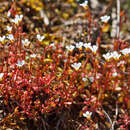en
names in breadcrumbs


Saxifraga tridactylites, the rue-leaved saxifrage[1] or "nailwort", is a species of plant in the family Saxifragaceae.
Rue-leaved saxifrage is an annual plant with distinctive, trilobed, fleshy leaves and red stems. These stems, the leaves and the sepals are covered in numerous sticky glands.
 Saxifraga tridactylites on limestone outcrop, Derbyshire, England.
Saxifraga tridactylites on limestone outcrop, Derbyshire, England. Saxifraga tridactylites, the rue-leaved saxifrage or "nailwort", is a species of plant in the family Saxifragaceae.
Rue-leaved saxifrage is an annual plant with distinctive, trilobed, fleshy leaves and red stems. These stems, the leaves and the sepals are covered in numerous sticky glands.